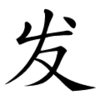发
Appearance
| ||||||||
Translingual
[edit]| Stroke order | |||
|---|---|---|---|
| Stroke order | |||
|---|---|---|---|

| |||
| Traditional | 發 |
|---|---|
| Shinjitai | 発 |
| Simplified | 发 |
| Traditional | 髮 |
|---|---|
| Shinjitai | 髪 |
| Simplified | 发 |
Han character
[edit]发 (Kangxi radical 29, 又+3, 5 strokes, cangjie input 戈女大水 (IVKE), four-corner 23407, composition ⿺⿸⿻𠃋丿又丶)
Derived characters
[edit]- 𭇜, 𫭨, 拨, 泼, 𩧯, 𭩰, 袯, 䥽, 𫏆, 酦, 废, 𬜧, 𬏦, 𬔹 (Simplified from the component 發 in mainland China)
- 𭇜, 𭘟 (Zhuang characters in mainland China)
- 𦫘, 𧸻 (Vietnamese characters, ⿺色发 and ⿰貝⿱髟发)
Related characters
[edit]- 發, 髮 (Traditional forms of 发)
References
[edit]- Kangxi Dictionary: not present, would follow page 165, character 27
- Hanyu Da Zidian (first edition): volume 1, page 394, character 1
- Unihan data for U+53D1
Chinese
[edit]Glyph origin
[edit]Simplified from 發 and 髮 in the 1956 Chinese Character Simplification Scheme by the People's Republic of China.
Etymology 1
[edit]| For pronunciation and definitions of 发 – see 發 (“to shoot; to launch; to issue; etc.”). (This character is the simplified form of 發). |
Notes:
|
Etymology 2
[edit]| For pronunciation and definitions of 发 – see 髮 (“hair; grass and trees; vegetation; etc.”). (This character is the simplified form of 髮). |
Notes:
|
Categories:
- CJK Unified Ideographs block
- Han script characters
- CJKV characters simplified differently in Japan and China
- Translingual lemmas
- Translingual symbols
- CJKV simplified characters
- Beginning Mandarin
- Chinese lemmas
- Mandarin lemmas
- Sichuanese lemmas
- Dungan lemmas
- Cantonese lemmas
- Taishanese lemmas
- Hakka lemmas
- Jin lemmas
- Eastern Min lemmas
- Hokkien lemmas
- Teochew lemmas
- Leizhou Min lemmas
- Puxian Min lemmas
- Southern Pinghua lemmas
- Wu lemmas
- Xiang lemmas
- Middle Chinese lemmas
- Old Chinese lemmas
- Chinese hanzi
- Mandarin hanzi
- Sichuanese hanzi
- Dungan hanzi
- Cantonese hanzi
- Taishanese hanzi
- Hakka hanzi
- Jin hanzi
- Eastern Min hanzi
- Hokkien hanzi
- Teochew hanzi
- Leizhou Min hanzi
- Puxian Min hanzi
- Southern Pinghua hanzi
- Wu hanzi
- Xiang hanzi
- Middle Chinese hanzi
- Old Chinese hanzi
- Chinese verbs
- Mandarin verbs
- Sichuanese verbs
- Dungan verbs
- Cantonese verbs
- Taishanese verbs
- Hakka verbs
- Jin verbs
- Eastern Min verbs
- Hokkien verbs
- Teochew verbs
- Leizhou Min verbs
- Puxian Min verbs
- Southern Pinghua verbs
- Wu verbs
- Xiang verbs
- Middle Chinese verbs
- Old Chinese verbs
- Chinese classifiers
- Mandarin classifiers
- Sichuanese classifiers
- Dungan classifiers
- Cantonese classifiers
- Taishanese classifiers
- Hakka classifiers
- Jin classifiers
- Eastern Min classifiers
- Hokkien classifiers
- Teochew classifiers
- Leizhou Min classifiers
- Puxian Min classifiers
- Southern Pinghua classifiers
- Wu classifiers
- Xiang classifiers
- Middle Chinese classifiers
- Old Chinese classifiers
- Chinese terms spelled with 发
- Chinese simplified forms
- zh:Hair
- Gan lemmas
- Northern Min lemmas
- Gan hanzi
- Northern Min hanzi
- Chinese nouns
- Mandarin nouns
- Sichuanese nouns
- Dungan nouns
- Cantonese nouns
- Taishanese nouns
- Gan nouns
- Hakka nouns
- Jin nouns
- Northern Min nouns
- Eastern Min nouns
- Hokkien nouns
- Teochew nouns
- Puxian Min nouns
- Wu nouns
- Xiang nouns
- Middle Chinese nouns
- Old Chinese nouns
- Chinese proper nouns
- Mandarin proper nouns
- Sichuanese proper nouns
- Dungan proper nouns
- Cantonese proper nouns
- Taishanese proper nouns
- Gan proper nouns
- Hakka proper nouns
- Jin proper nouns
- Northern Min proper nouns
- Eastern Min proper nouns
- Hokkien proper nouns
- Teochew proper nouns
- Puxian Min proper nouns
- Wu proper nouns
- Xiang proper nouns
- Middle Chinese proper nouns
- Old Chinese proper nouns
